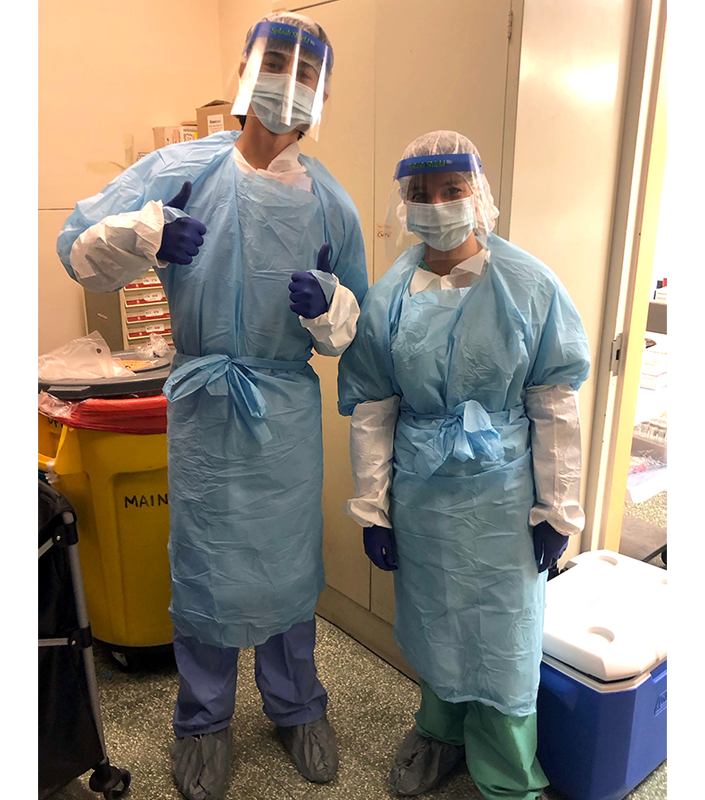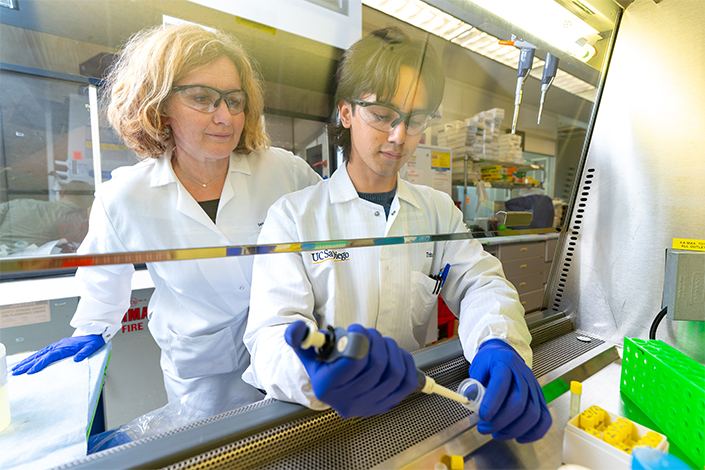Career Anatomy – Alec Guerra
Story by:
Published Date
Story by:
Topics covered:
Share This:
Article Content
Alec Guerra always got good grades, but when he aced his anatomy class at Mater Dei High School in Chula Vista, he felt a career calling to him.
“I was like, wow, I need to pursue medicine, this is my thing,” he said.
He couldn’t have guessed that just a few years later he would be assisting at an autopsy on a real human body donor in a UC San Diego morgue.
Since he was a little kid, Guerra had dreamed of becoming a professional athlete.
“ I would wear soccer jerseys to school every single day when I was a kid, that was my life,” he said.
In high school, he took up golf, which he continues to play semi-professionally in the U.S. and Mexico to this day. But like most young athletes, he knew he should be realistic about his long-term career goals.

“Although I was really good at the sports and it was still a possibility to play in college, I wanted to do something that had more longevity to it,” Guerra said.
His anatomy class solidified his interest in becoming a physician, and when COVID-19 hit, he used his down time to research every possible medical career, eventually landing on the field of radiology. He was intrigued by its impact on a wide range of diseases and conditions, but also by the evolving nature of the field.
“Radiology is going to look a lot different in 10, 15 years — there's going to be a lot of new technology that comes out from now until then,” he said, enthusiastic about the chance to keep up with cutting-edge advances.
Guerra had hoped to attend UC San Diego to pursue his pre-med studies, but he wasn’t accepted the first time he applied. He headed to Mesa College in the fall of 2022 to major in human biology with the hope of transferring to UC San Diego in two years. To attain his career goals, Guerra knew he would need to gain research experience. That’s where the CADRE program came in.
“Our mission is to expose students on our campus to at least one component of internship work experience so that they get hands-on training before transferring,” said Pavel Consuegra, an adjunct professor and work-based learning internship coordinator with the Mesa Impactship Program. “We try to work with the student population as soon as they join Mesa College. With CADRE, we saw the opportunity to expose our students to a high-end research institution.”
“ I couldn't believe what I was doing … I woke up that morning and within an hour I was in a morgue doing an autopsy.”
Guerra’s mentor, Sara Gianella Weibel, M.D., is a professor of medicine at UC San Diego School of Medicine and director of the San Diego Center for AIDS Research (CFAR) Translational Virology Core, which investigates how Human Immunodeficiency Virus (HIV) persists in tissues throughout the human body. She signed up to be a CADRE mentor because of her passion for social justice and mentoring the next generation of biomedical scientists.
“I feel that the CADRE program really is at the intersection of both,” she said. “ One of my big goals in life is to help more young people from underrepresented backgrounds to be successful and to diversify the medical workforce.”
Gianella Weibel says Guerra impressed her right away by his eagerness to learn. They also connected over their shared interest in anatomy. Guerra took on a variety of tasks in the lab — from organizing the inventory of frozen tissue samples and testing his teammates weekly for COVID-19, to shadowing the day-to-day activities of the clinical research coordinator and helping laboratory technicians extract DNA from samples.
“We were really trying to give him the best, complete, holistic experience,” she said.

Sara Gianella Weibel, M.D., mentored Alec Guerra in the San Diego Center for AIDS Research (CFAR) Translational Virology Core. Photo credit: Kyle Dykes/UC San Diego Health Sciences
But the experience that left the biggest impression on Guerra was his participation in an autopsy for the Last Gift study. “We enroll terminally sick people with HIV who want to participate in HIV cure research by donating their body,” said Gianella Weibel. “ It is without any doubt the most successful project that we have going on and almost everyone in our team volunteers. They feel really invested because they understand the importance of what our role is to fulfill the wish that the participant has to give back to the community by donating their tissue.”
When a patient dies, she says there is a six-hour window during which an autopsy must be performed before tissues start to deteriorate.
“Dr. Gianella Weibel texted me that a patient had passed and they're going to perform the autopsy,” said Guerra. “She asked me if I wanted to go and so I got up and raced over there. I couldn't believe what I was doing … I woke up that morning and within an hour I was in a morgue doing an autopsy.”
When he arrived at the morgue, he donned two layers of scrubs and full personal protective equipment (PPE).
“When I first put the protective gear on, it was super hot and I couldn't breathe, but honestly, I forgot about all the layers of clothes that I had on because I was just so amazed at what I was doing,” said Guerra.
Guerra assumed he would just be observing, but was quickly assigned the task of flash-freezing tissues from the autopsy in liquid nitrogen.
Gianella Weibel says an autopsy can be an intense experience for students, so she tries to keep them busy so they don’t overthink it. “We make sure that they understand the importance of what they are about to see, but the work in the morgue is mostly learning by doing.”
Guerra was surprised by how much he enjoyed the work in Gianella Weibel’s lab.
“ Initially, it was something that I had to do because if I want to go to medical school, I need these hours of research,” he said. “But it's been great to actually go to work every day and genuinely look forward to what I'm going to be doing.”
At the end of the eight week internship, the lab hired Guerra as a part-time employee.
“And now he's basically single-handedly leading the cleanup of the freezers,” said Gianella Weibel. “He has been a great addition to the team.
Stay in the Know
Keep up with all the latest from UC San Diego. Subscribe to the newsletter today.




